Physical Address
304 North Cardinal St.
Dorchester Center, MA 02124
Physical Address
304 North Cardinal St.
Dorchester Center, MA 02124
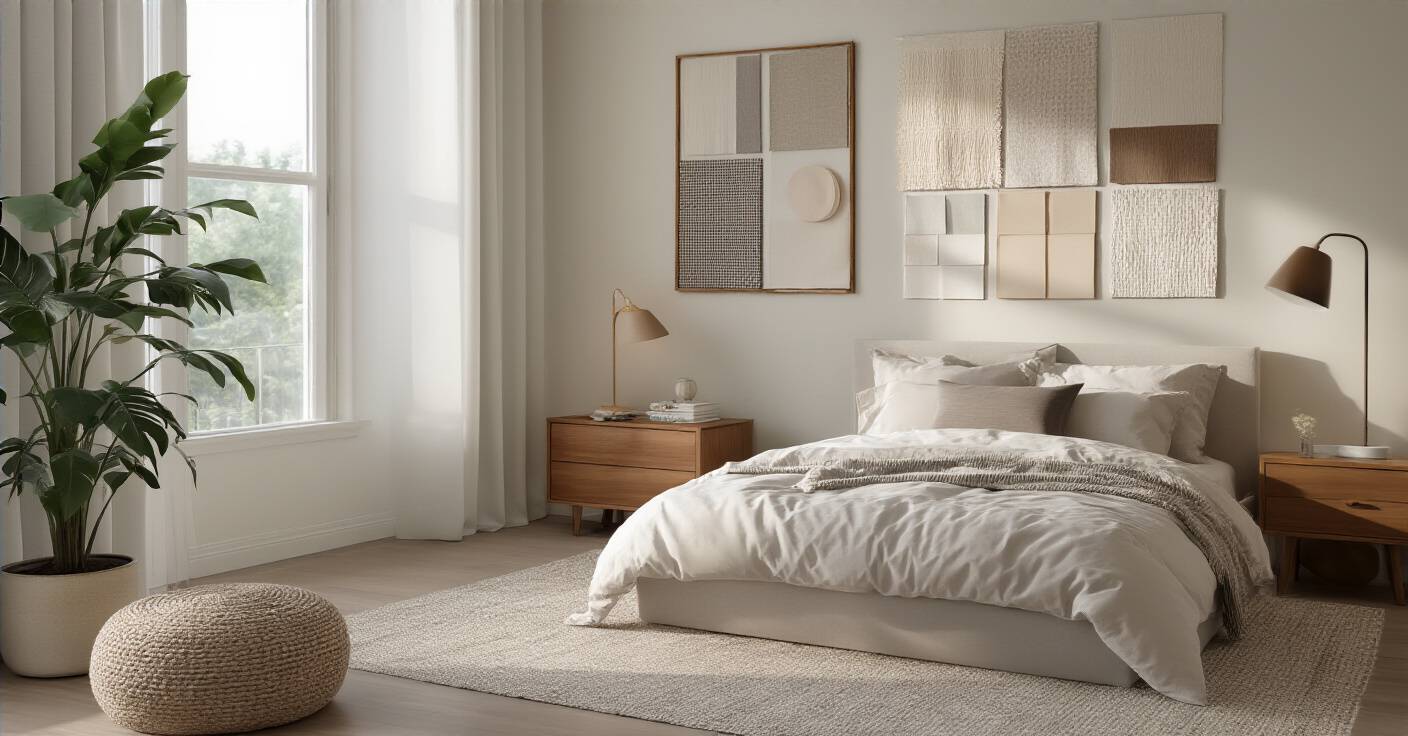
Transform your apartment bedroom into a wellness sanctuary. These 24 smart design ideas maximize space and style to boost your energy, recovery, and focus.
Can we talk about why everyone gets apartment bedrooms so, so wrong? It drives me nuts. People treat them like a closet you can cram a mattress into. It’s the last room to get any attention, a dumping ground for laundry and whatever doesn’t fit in the living room. But here’s the reality check: your bedroom is your single most important wellness tool. It’s your personal recharge station. It’s where your body and mind recover, repair, and build strength for the next day. If you’re trying to crush a workout, hit a deadline, or just feel good, it all starts with the quality of your recovery.
A chaotic, cluttered, poorly designed bedroom actively works against you. It spikes your cortisol levels before you even fall asleep and greets you with stress the moment you wake up. It’s like trying to build muscle while only eating junk food. It just doesn’t work. As a trainer and a designer, I’ve seen it a thousand times: a beautiful, functional bedroom isn’t a luxury; it’s a foundation for a healthier, more energetic life. So let’s cut the fluff. Here’s how to turn that small, awkward space into a powerhouse of style and function that you’ll actually want to be in.
Before you even think about buying a cool-looking lamp, you need to do the groundwork. This is the warm-up, the mobility work of design. Skipping this step is like trying to hit a personal record on a deadlift with cold muscles. You’re just asking for an injury—or in this case, a room that doesn’t work and a wallet that’s crying for help. Let’s get it right from the start.
You know what people always ask me? “What style is ‘in’ right now?” And I always tell them: Who cares? Your bedroom isn’t a magazine cover; it’s your sanctuary. The real question is, how do you want to feel in this space? Calm? Energized? Cozy? Focused? Forget generic labels like “modern” or “boho” for a second. The goal is to build a room that brings down your heart rate and lets you breathe. A room that looks and feels like you.
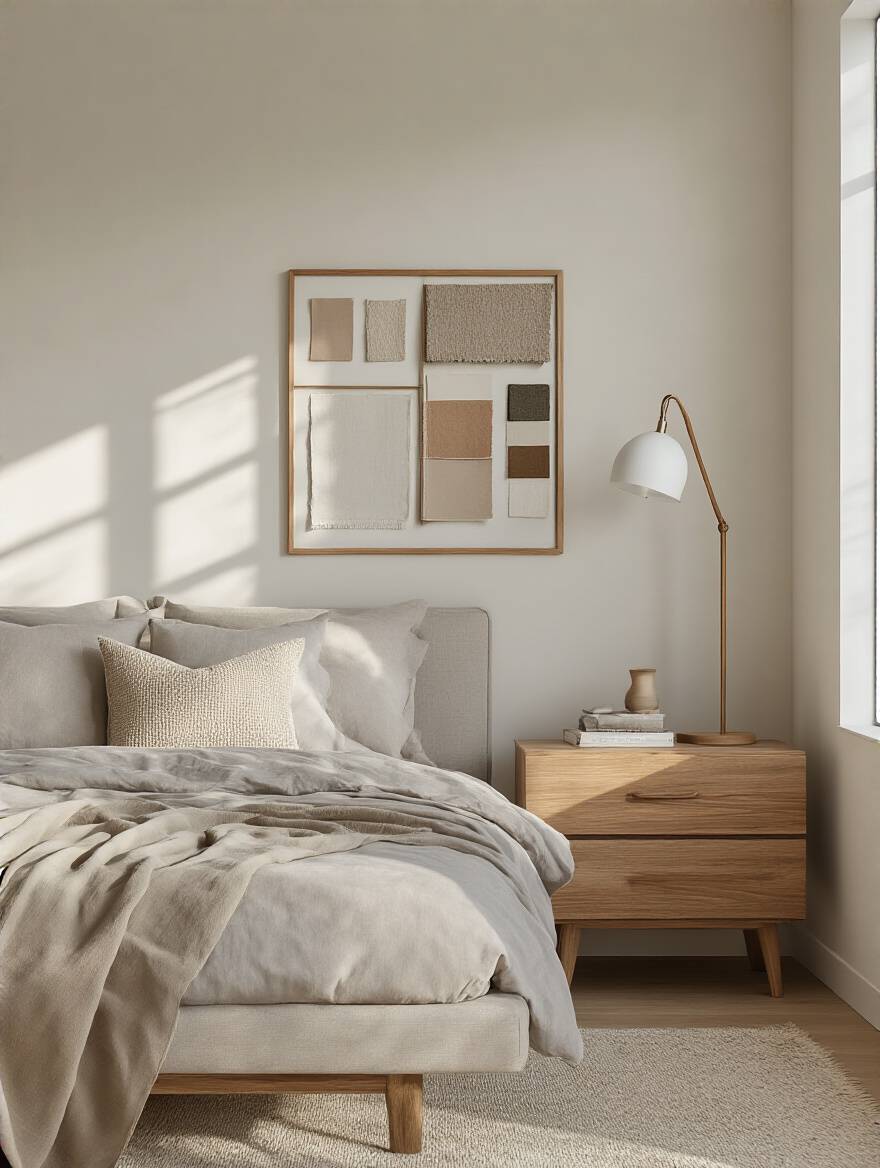
I once had a client, a high-stress lawyer, who tried to force a minimalist, all-white bedroom because he thought it was sophisticated. He hated it. It felt cold and sterile. We switched to warm woods, deep blues, and soft textures, and his Sleep Quality immediately improved. Your style is a tool. Use it to create an environment that supports your well-being, not one that just follows a trend. Go on Pinterest, but instead of saving “minimalist bedroom,” search for words like “calm,” “restful,” or “cozy retreat.” The patterns will emerge.
With a clear feeling in mind, you need to get real about the actual physical space you’re working with.
Okay, confession time. Early in my career, I eyeballed a client’s space for a custom shelving unit. I was off by two inches. It cost me hundreds of dollars and a ton of embarrassment to fix. Learn from my mistake: Measure. Everything. Twice. Don’t just get the length and width of the walls. Measure the height. Measure the windows, the doors (and how they swing open!), the distance from the corner to the electrical outlet. Everything.
Get a real metal tape measure, not a flimsy one. Write it all down on a piece of paper or, even better, a free floor planner app. Then, use painter’s tape on the floor to mark out where potential furniture will go. Physically walk around it. Can you open your drawers? Can you do your morning stretches without kicking a dresser? A piece of furniture can look perfect online, but if it blocks your flow, it’s just expensive, stylish clutter.
Once you know what fits, you need to know what you can afford.
Let’s be real: a budget isn’t a restriction; it’s a game plan. It’s how you win. Going into a redesign without a budget is like starting a new fitness program without a plan—you’ll do a bunch of random stuff, get tired, and see zero results. You’ll end up with a couple of expensive things you love and a bunch of cheap compromises because you ran out of cash. The result is always a mess.
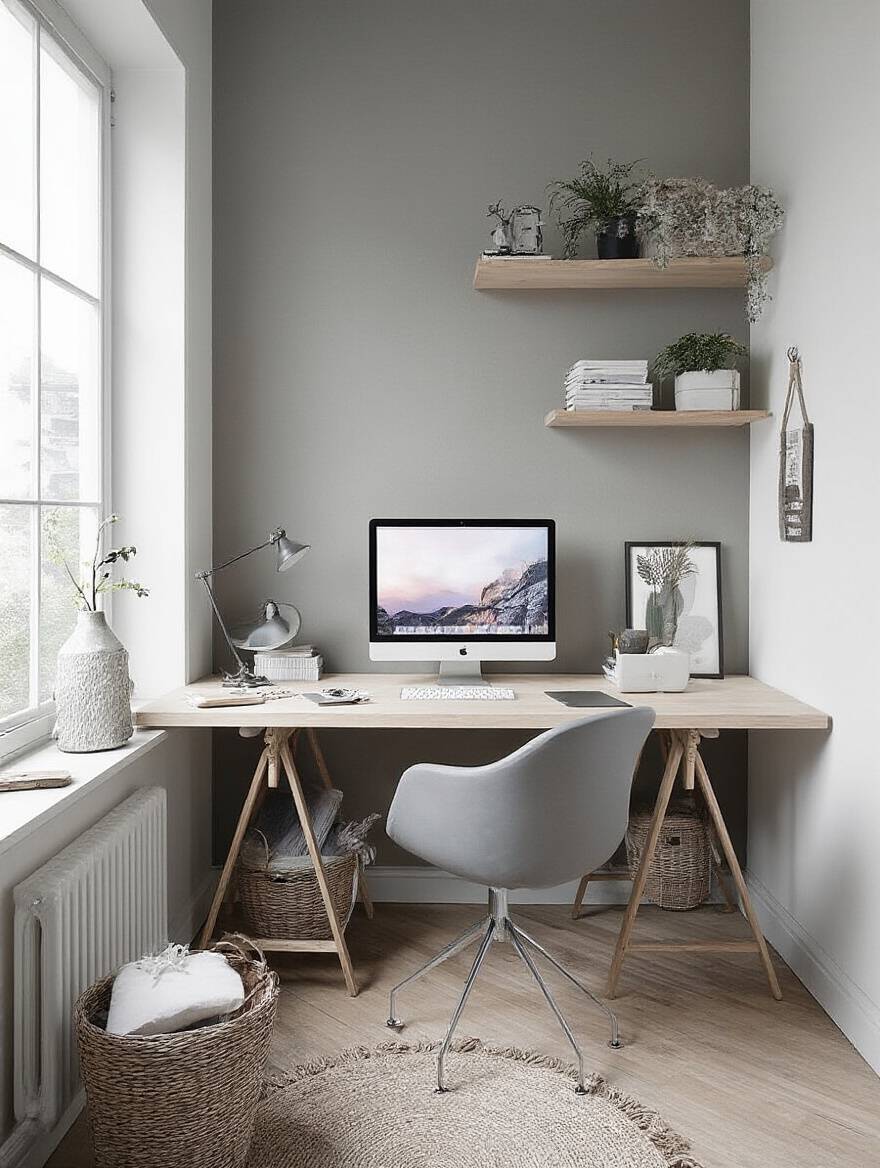
Decide on your absolute max number, then work backward. List your non-negotiables first. For me, that’s always a quality mattress. Your sleep is paramount. Maybe for you, it’s a good desk or blackout curtains. Allocate the most money there. Then, for everything else, be a hunter. Look for deals, check out secondhand shops, or get creative with DIY. And always, always set aside 10-15% of your total budget for a contingency fund. Deliveries get delayed, things break, you change your mind. That little buffer is what keeps the project from becoming a major source of stress.
With your budget locked in, it’s time to decide what this room really needs to do for you.
Your bedroom can’t be everything to everyone. Especially not in a small apartment. You have to be ruthless and decide its number one job. Is it purely a sleep sanctuary? Is it a storage workhorse for your massive collection of workout gear? Or does it need to double as your full-time office? Trying to make it all three equally will mean it fails at all of them.
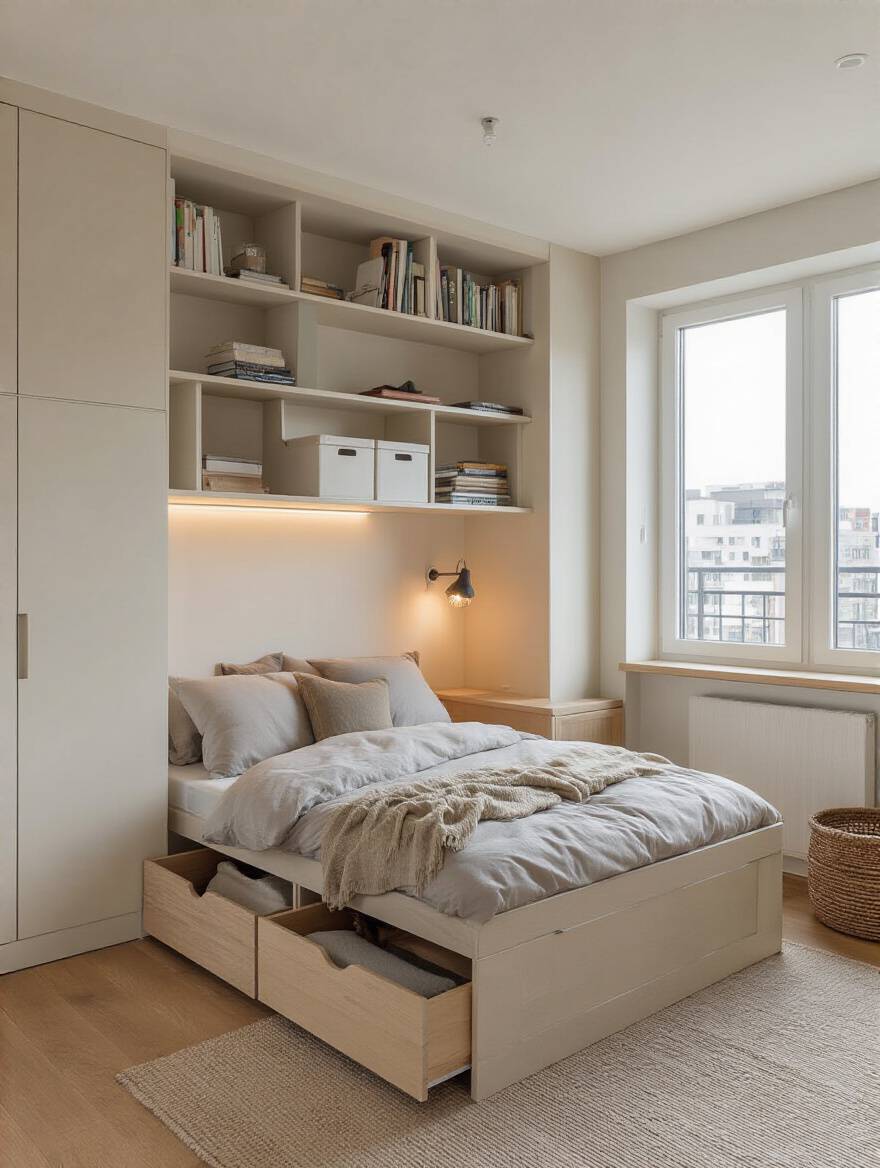
I had a client who was a personal trainer working from home. He was trying to cram a desk, his bed, and all his equipment into one room. He was stressed, couldn’t sleep, and felt like he was always at work. We made a tough call: the room’s primary function was rest. We moved his desk to a small nook in the living room and focused the bedroom on amazing storage for his gear and creating a zen-like sleep space. His sleep improved, and his work became more focused because there was a clear separation. Be honest with yourself. Rank your needs, and let that #1 priority dictate your biggest decisions.
And a huge part of that is figuring out your room’s natural energy source: the sun.
Natural light is your body’s alarm clock and its natural energizer. It dictates your circadian rhythm, which in turn impacts everything from your mood to your metabolism. You need to understand how the sun moves through your room. Where is the bright, direct light in the morning? Where does it get that sleepy, soft glow in the afternoon? This is non-negotiable information for your layout.
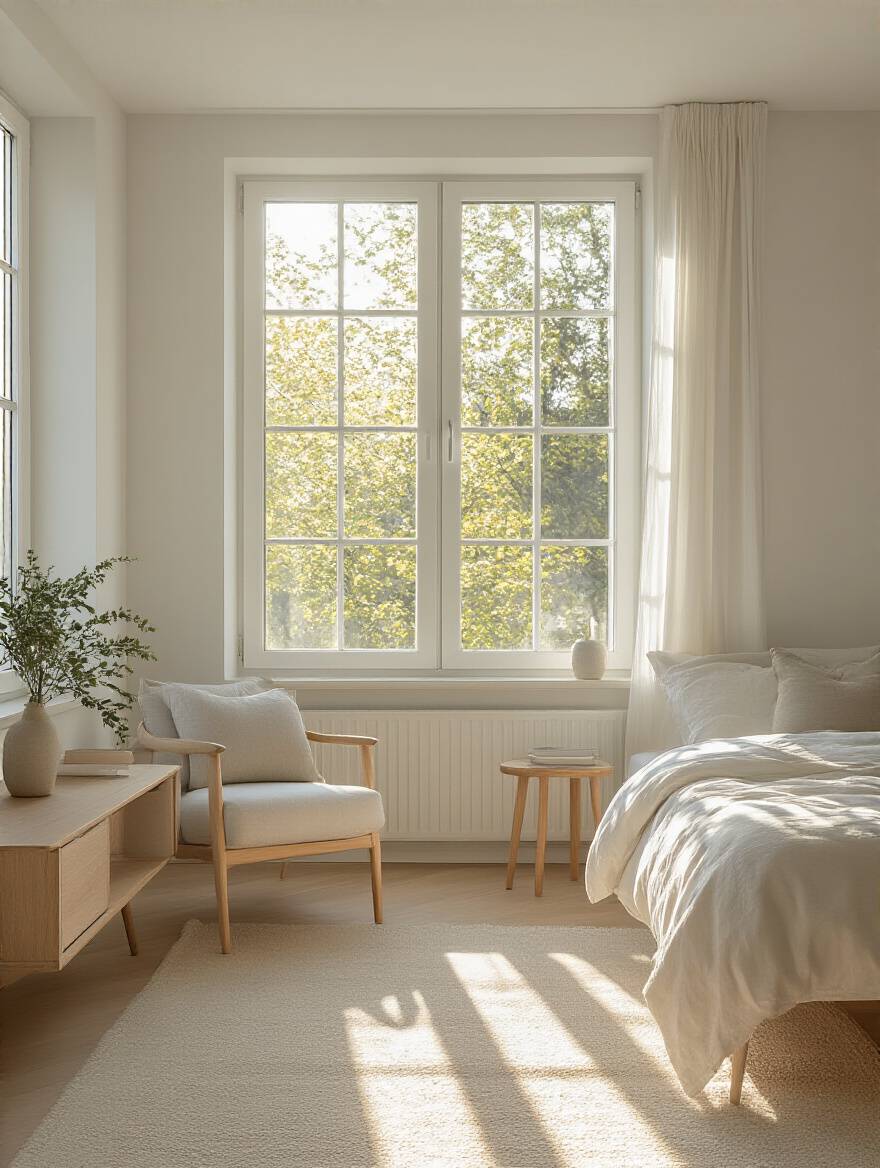
Don’t put your desk where you’ll get a massive glare on your screen at 2 p.m. And maybe don’t put your bed right where the sunrise will blast you in the face if you’re not an early bird. I always tell my clients to place their main “activity” zones in the best light. If you have a reading chair, put it in that soft afternoon light. If you have a small space for a morning yoga routine, make sure it’s in that energizing morning sun. You’re working with your body’s natural rhythm, not against it.
Now, take all this intel and put it down on paper.
I know, this sounds like homework. But trust me, a five-minute sketch can save you hours of back-breaking furniture moving and hundreds of dollars in return fees. You don’t need to be an architect. Just grab a piece of graph paper (where one square equals one foot) and draw the outline of your room, including the windows and doors.
Then, cut out little paper squares to represent your furniture—the bed, the dresser, a chair—all to scale. Now you can play Tetris with your room without breaking a sweat. Slide the pieces around. See how different layouts feel. Does this leave a clear path from the door to the bed? Can you open the closet all the way? You’ll spot problems on paper that you’d never see until it’s too late. It’s the easiest, cheapest way to build a room that actually flows.
Alright, warm-up is done. Now for the main workout. This is where we get clever and make every single inch of your apartment bedroom work as hard as you do. We’re going to fight back against “small” and “cramped” with smart, strategic moves that create space you didn’t even know you had.
In an apartment, every piece of furniture has to earn its spot. I’m talking about workhorses, not show ponies. Multi-functional furniture isn’t just a “nice-to-have”; it’s a non-negotiable. Why have a bed frame when you can have a bed frame with built-in drawers that replaces an entire dresser? Why have a simple bench when you can have an ottoman that stores your extra blankets and doubles as a seat?
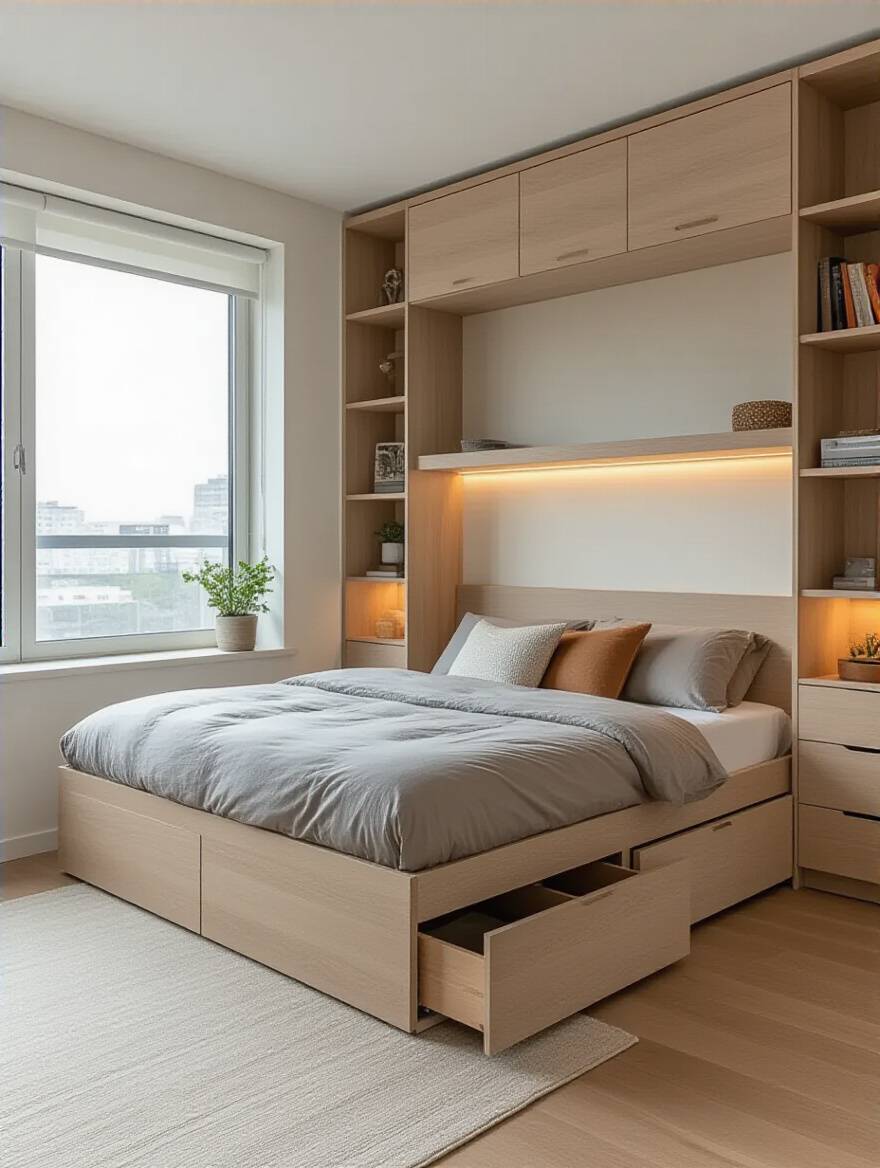
Think about it in terms of efficiency, just like a compound exercise in the gym. A squat works your glutes, quads, and core all at once. A storage bed gives you a place to sleep and a place to store things. It’s a two-for-one. One of my favorite moves for clients in studios is a Murphy bed with a fold-down desk. By day, it’s a full-on workspace. At night, the whole room transforms into a dedicated, uncluttered sleep zone. That’s how you make one room feel like two.
Once you have your heavy-lifting furniture, it’s time to look up.
Everyone complains about not having enough floor space. My answer? Stop looking at the floor! The most valuable real estate in any small apartment is the vertical space from your head to the ceiling, and most people completely ignore it. Getting your stuff off the floor and onto the walls is the fastest way to make a room feel bigger, cleaner, and more organized.
Think about tall, narrow bookcases that draw the eye up. Think about floating shelves above your desk or dresser to hold books and decor. My personal favorite is a picture ledge mounted above the bed instead of a bulky headboard. It holds art, small plants, and your phone, all without taking up a single square inch of floor. You’re literally reclaiming dead space and turning it into functional, stylish storage.
And while you’re looking up, let’s talk about the oldest trick in the book for a reason.
This isn’t just designer BS, it’s straight-up physics. Dark colors absorb light, making walls feel like they’re closing in on you. Light colors—whites, soft grays, pale blues, sage greens—have a high Light Reflectance Value (LRV). That just means they bounce light around the room, creating an illusion of space and airiness. It’s the easiest, cheapest, and most effective way to make a small room feel bigger.
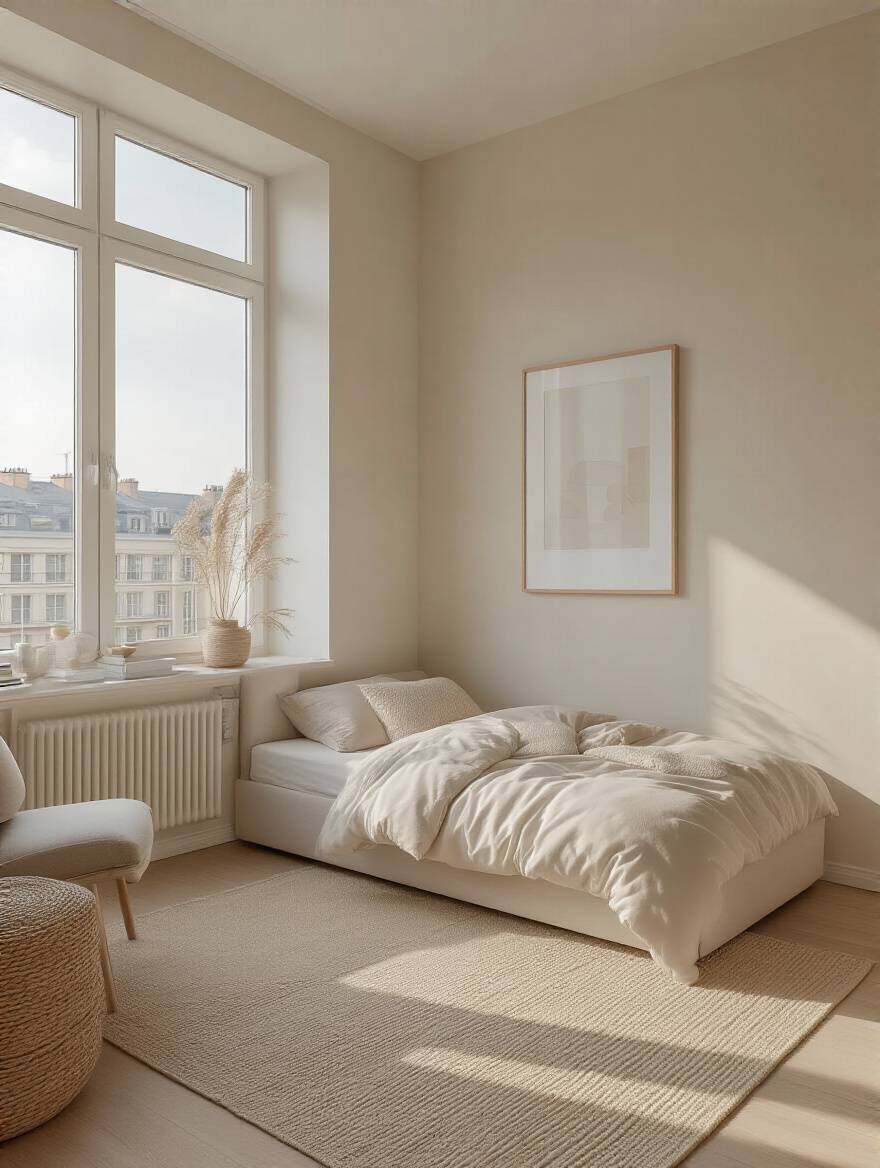
But “light” doesn’t have to mean “boring clinical white.” Look for whites with warm undertones (like Swiss Coffee) to make it feel cozy, or a very light gray with a hint of blue for a serene, calming vibe. And here’s the pro move: paint the ceiling the same color as the walls, or even a shade lighter. It erases the hard line between wall and ceiling, making the whole room feel taller and more expansive.
Speaking of expansive, let’s find some space you’re definitely not using.
The space under your bed is a black hole of dust bunnies and lost socks for most people. For us, it’s prime real estate. It’s like finding an extra closet you didn’t know you had. If your bed frame is sitting flat on the floor, you’re missing out on a massive storage opportunity. It’s the perfect spot for things you don’t need every day: seasonal clothes, extra bedding, workout equipment, your shoe collection.
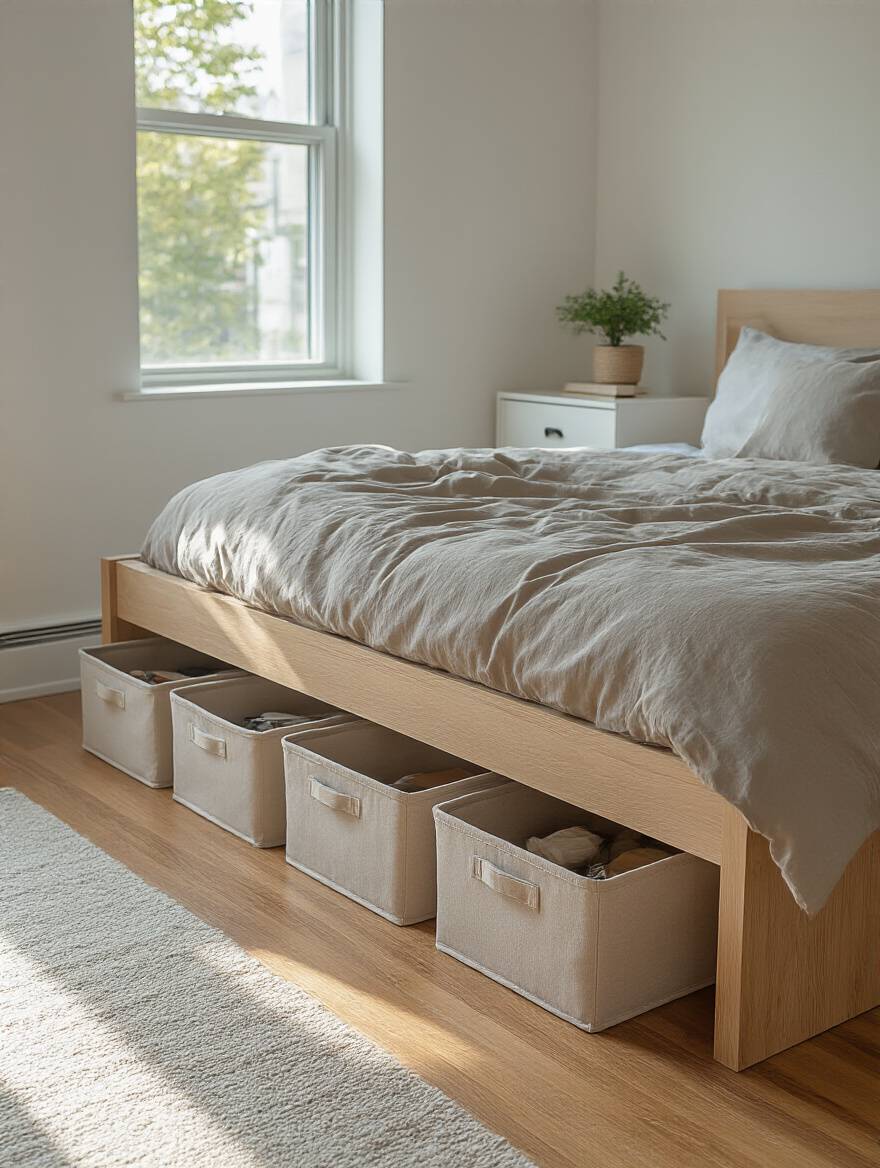
You can go for simple, low-profile rolling bins or vacuum-seal bags to compress bulky items like winter coats and duvets. But the best-case scenario is a bed frame with built-in drawers. It’s seamless, clean, and ridiculously efficient. A client of mine ditched his bulky dresser entirely and got a platform bed with four huge drawers underneath. It instantly opened up his room and made the whole space feel about 30% bigger. It’s hidden, it’s smart, and it clears up so much visual clutter.
Building on that idea, let’s take that same principle to your walls.
If under-bed storage is your hidden closet, wall shelves are your open-air display and utility belt. They are the ultimate workhorse for getting things off your surfaces and up onto the walls where they can be both useful and beautiful. The goal isn’t just to store things, but to do it strategically. A few well-placed shelves can replace a whole bookcase or a pair of nightstands.
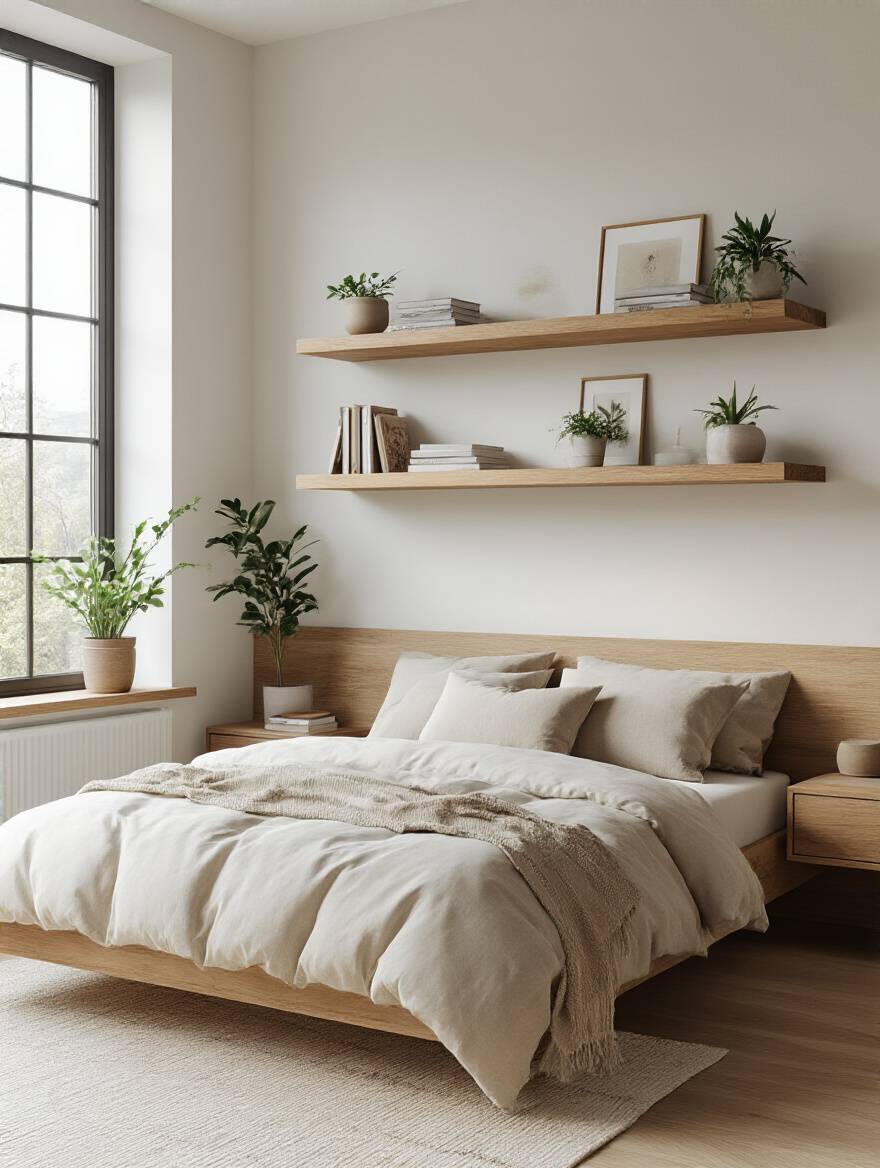
I love installing a series of shelves in an unused corner, creating a vertical library. Or placing a single, long shelf above a dresser to hold jewelry, perfume, and small art, freeing up the entire surface below. A great hack for tiny rooms is to mount a small floating shelf next to the bed to act as a minimalist nightstand—just enough room for a book, your phone, and a small lamp, without any floor footprint. It keeps things accessible but out of the way.
Now that we’re getting things off the floor, let’s play with some light and reflection.
Okay, this is another classic, but people still get it wrong. They hang a tiny little mirror and wonder why the room doesn’t look bigger. Here’s the rule: go big or go home. A large, substantial mirror is like adding a window to your room. It bounces light around, creates an illusion of depth, and can completely transform a space.
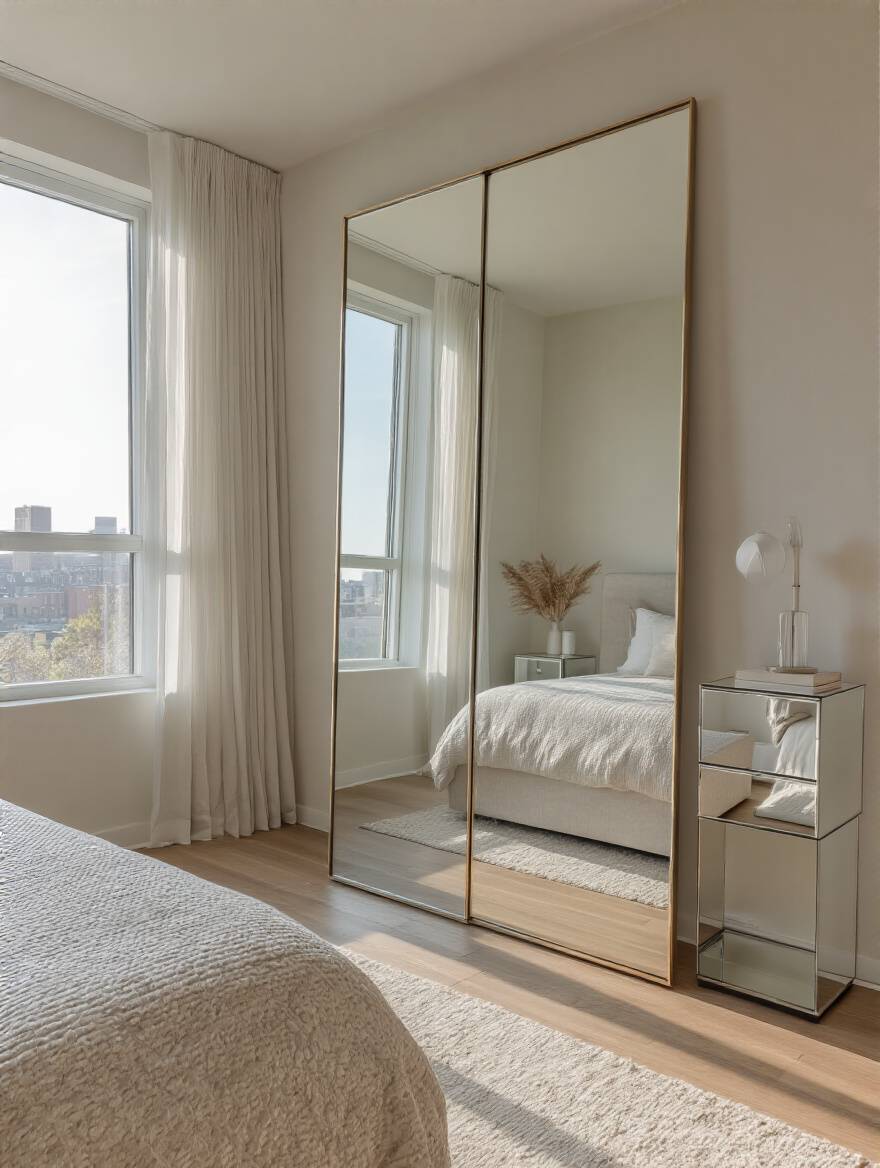
The number one placement strategy is to hang a big mirror directly opposite a window. It will literally double the amount of natural light in the room and reflect the view, making it feel like you’re surrounded by open space. Another power move is a full-length floor mirror just leaning against a wall. It not only makes the room feel taller, but it’s also practical—perfect for checking your outfit or even your form during a quick bodyweight workout. Don’t be timid with mirrors; they are your best friend in a small space.
Alright, we’ve made the space functional. Now let’s make it a place you actually love being in. This is the “cool-down” phase of our design workout. It’s all about layering in the elements that create comfort, reduce stress, and turn your bedroom into a true sanctuary. This is what makes a room feel like home.
We talked about light colors for space, but now let’s talk about a cohesive palette for serenity. A random mix of colors is visual noise. It’s jarring and keeps your brain in an alert state, which is the last thing you want when you’re trying to wind down. A cohesive palette—even if it’s just a few shades of the same color—is instantly calming. It tells your brain everything is in harmony and it’s safe to relax.
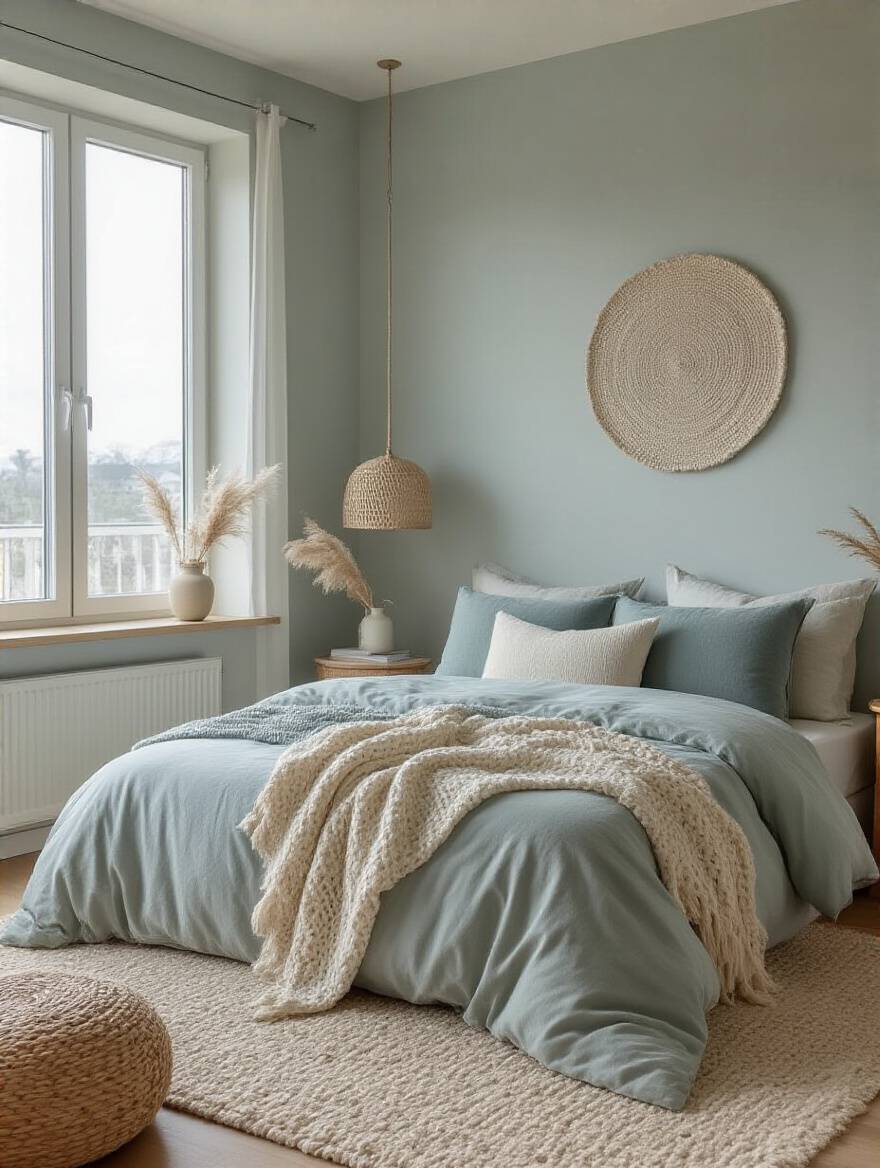
The easiest way to do this is to pick one main color you love (say, a soft sage green), and then layer in different tones and textures of that color, along with supporting neutrals like cream, beige, or light gray. Think sage green walls, a slightly darker green duvet, cream-colored sheets, and a natural wood nightstand. It creates depth and interest without being chaotic. This simple act of color discipline can make your room feel like a high-end hotel suite.
After you nail the colors, it’s time to bring in the feeling of touch.
A room with only flat, smooth surfaces feels cold and one-dimensional. Layering different textures is how you add warmth, depth, and that irresistible cozy factor. It’s the difference between a sterile showroom and a room that begs you to curl up with a book. I’m talking about the interplay of a soft knit blanket, a plush velvet pillow, a crisp linen duvet, and a rough-woven rug.
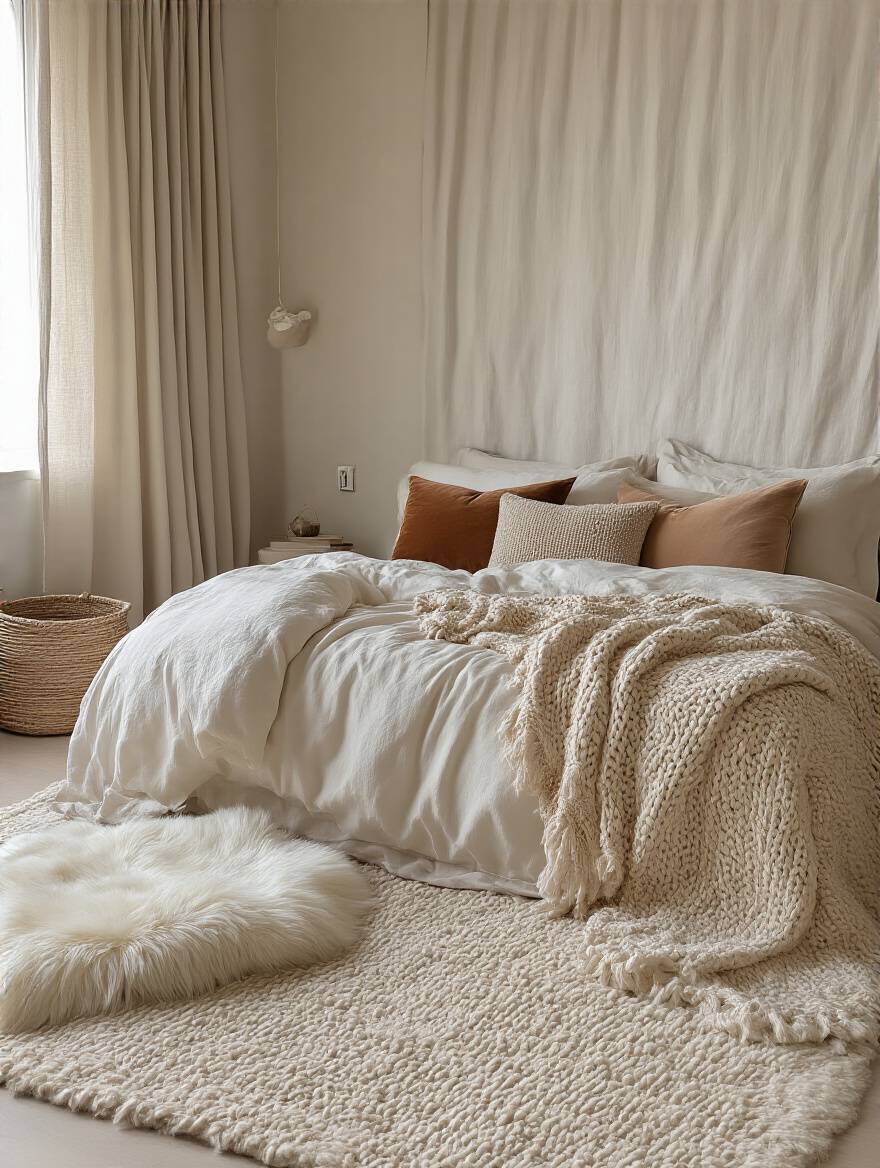
The bed is your main stage for this. Start with your sheets, add a duvet or quilt, then a folded throw blanket at the foot of the bed, and finish with a mix of pillows in different sizes and materials. But don’t stop there! Think about textured curtains, an upholstered headboard, or a sheepskin throw draped over a chair. These tactile elements make a room feel richer and more luxurious, and they also help absorb sound, making your room quieter and more peaceful.
With the textures in place, let’s get the lighting just right.
Relying on a single, harsh overhead light is a cardinal sin of bedroom design. It’s unflattering, creates weird shadows, and is totally inflexible. Layered lighting is the key to creating a space that can be bright and energizing for getting dressed in the morning, and soft and cozy for winding down at night. You need at least three layers.
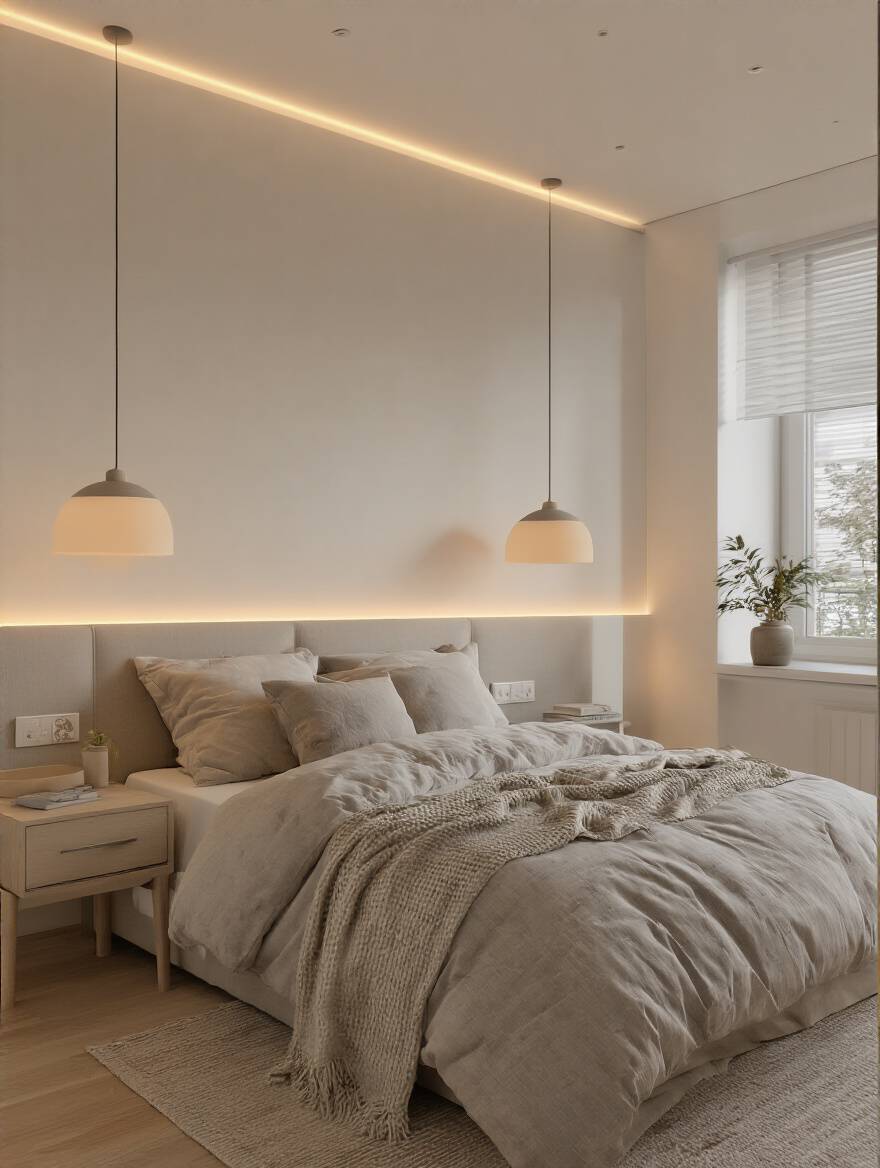
First is ambient light: the general, overall illumination. This can be a dimmable flush-mount fixture on the ceiling or a couple of wall sconces. Second is task light: focused light for specific activities. Think a bedside lamp for reading or a small desk lamp. Third is accent light: the mood-setter. This is the fun stuff—maybe some LED strip lighting behind your headboard for a soft glow, or a single beautiful floor lamp in a corner. Having multiple, controllable light sources gives you complete power over the room’s atmosphere.
Next, we bring some actual life into the space.
Humans are not meant to live in sterile boxes. We have an innate need to connect with nature, and bringing plants into your bedroom is the easiest way to do it. It’s not just about aesthetics; it’s about well-being. Plants are proven to purify the air, reduce stress, and boost your mood. Waking up in a room with living, breathing greenery is just… better.
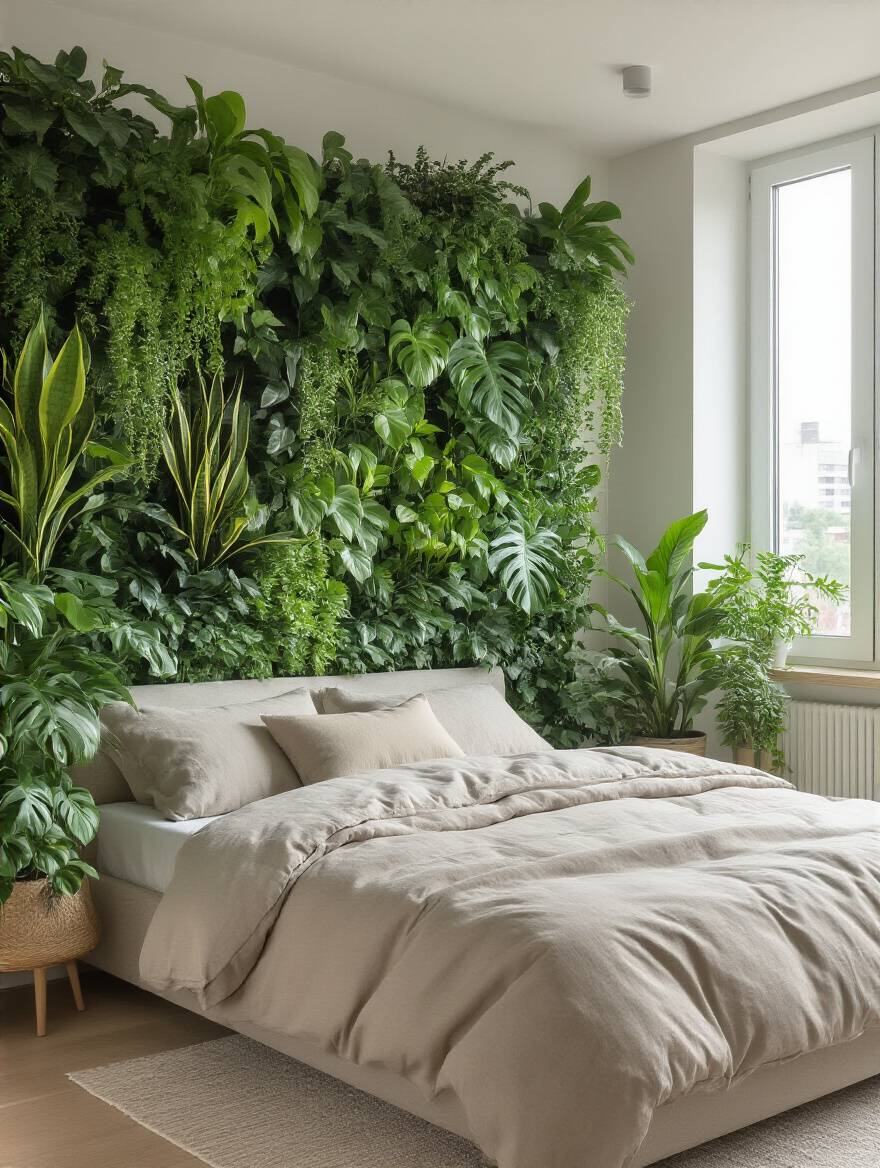
You don’t need to turn your room into a jungle. Start with one or two easy-to-care-for plants. A Snake Plant is nearly indestructible and is a powerhouse air purifier. A Pothos is beautiful and will tell you when it needs water by drooping a little. Put one on your dresser and hang another from the ceiling in a corner to draw the eye upward. They add a pop of color, life, and freshness that you just can’t get from anything else.
And while plants tell a story of nature, the next step is about telling your story.
This is where you make the room truly, uniquely yours. Ditch the generic, mass-produced “Live, Laugh, Love” signs. Your walls are a canvas for your story. Frame photos from your favorite trip. Hang a print from a local artist you admire. Display an object that has sentimental value. This is what turns a room into a sanctuary. It’s a space that reflects who you are and what inspires you.
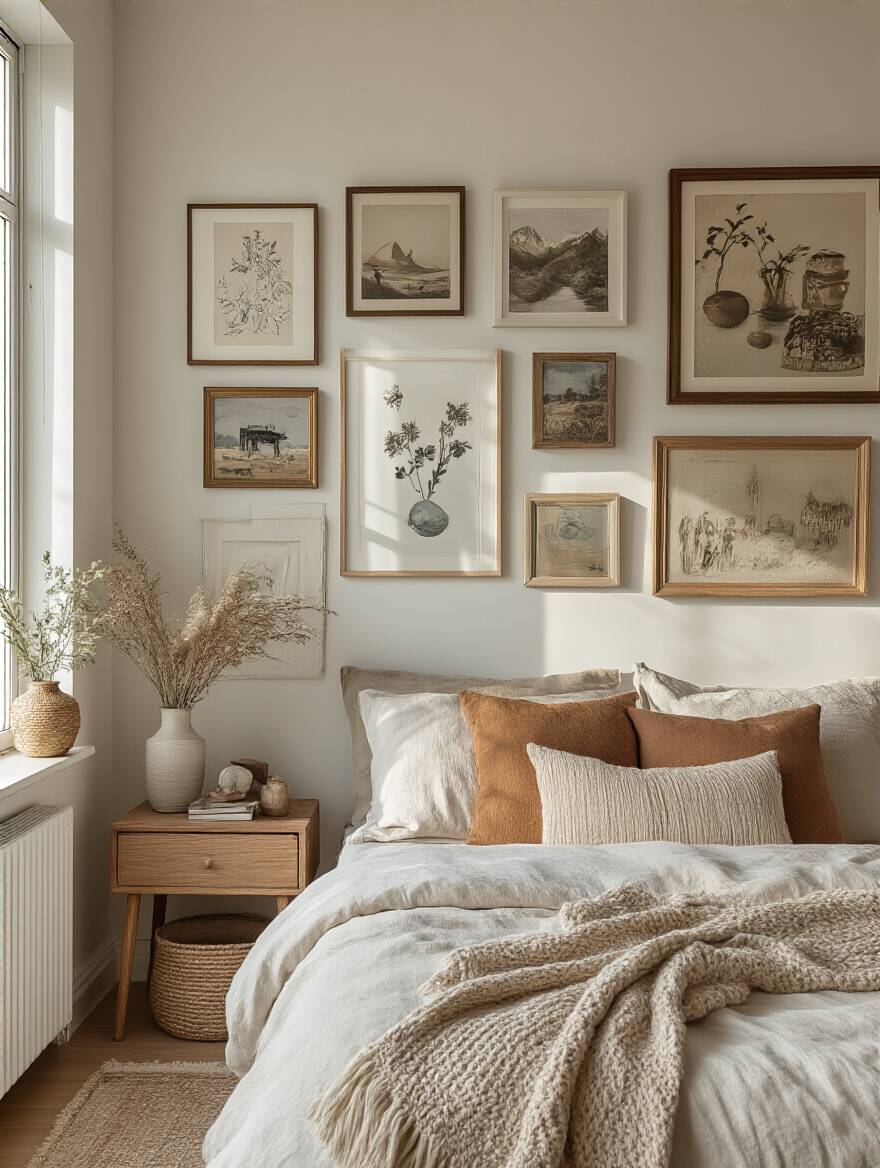
I had a client who was training for a marathon. We created a small gallery wall next to her bed with a framed map of the race route, a few inspirational quotes from runners she admired, and a photo of the finish line from the previous year. It was the first thing she saw in the morning and the last thing she saw at night. It wasn’t just decor; it was a daily dose of motivation. Your art should work for you, reminding you of your goals, your loves, and your accomplishments.
With the vibe set, there’s one more critical element for comfort: pure darkness.
This is not a suggestion; it’s a command. If you’re serious about your sleep—which is to say, if you’re serious about your health—you need blackout curtains or blinds. Even a tiny bit of light from a streetlight or the morning sun can disrupt your body’s production of melatonin, the hormone that governs sleep. A darker room means deeper, more restorative sleep. Period.
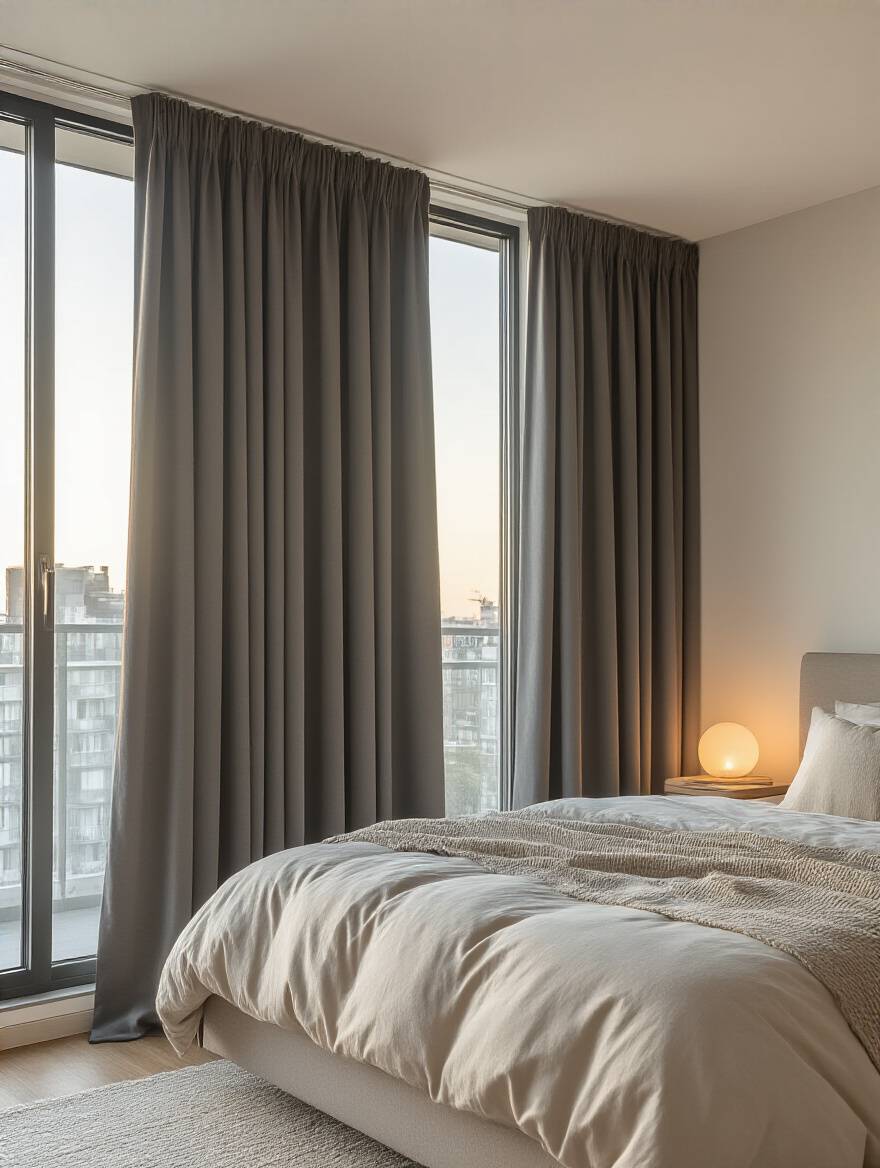
Look for curtains labeled “100% blackout” or cellular shades with light-blocking side channels. Make sure your curtain rod extends several inches past the window frame on either side so you can wrap the curtain around to block light leakage. I’ve had so many clients—especially those in busy cities—tell me that installing proper blackout curtains was the single biggest game-changer for their energy levels. It’s a simple upgrade with a massive ROI for your well-being.
You’ve built the foundation and layered in the comfort. Now for the pro-level moves. This is about the fine-tuning that keeps your room looking amazing and functioning effortlessly for the long haul. It’s about tackling the little annoyances that create clutter and chaos, so your sanctuary stays a sanctuary.
A messy closet is a source of daily stress. You can’t find anything, your clothes get wrinkled, and it just starts your day on a chaotic note. The fix isn’t a bigger closet; it’s a smarter closet. A few strategic inserts can literally double your usable space and make getting ready in the morning a breeze.
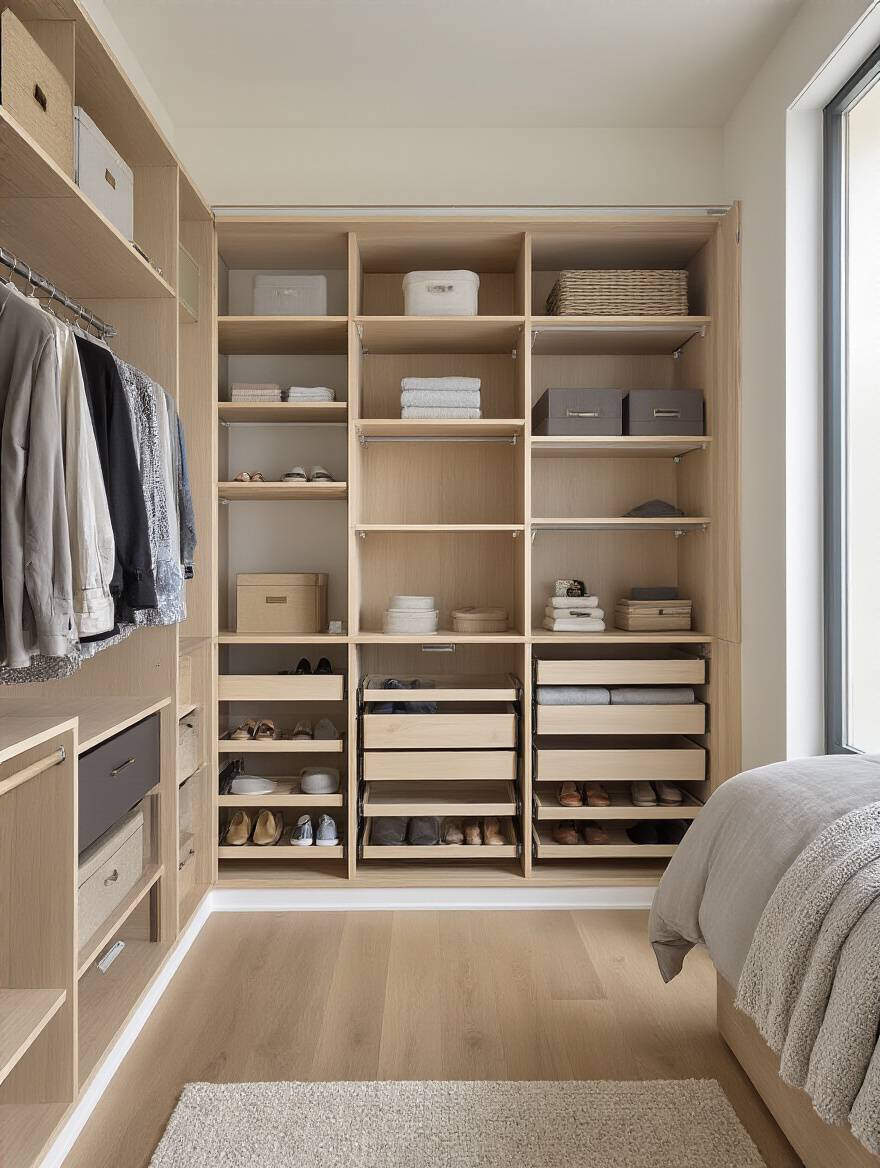
Start with slim-profile velvet hangers—they save a ton of space and your clothes don’t slip off. Then add a hanging shoe organizer, a double-hang closet rod to create a second level of hanging space for shirts and pants, and some clear bins or drawer dividers for your shelves. Every single thing should have a designated home. When your closet is hyper-organized, you spend less time stressing and more time living.
Once your clothes are handled, it’s time to battle the digital octopus.
Nothing kills a calm, beautiful vibe faster than a tangled mess of cords and cables. It’s visual chaos. That “cable spaghetti” behind your TV or next to your bed is sending a constant, low-level stress signal to your brain. Getting it under control is one of the most satisfying and impactful things you can do for your room.
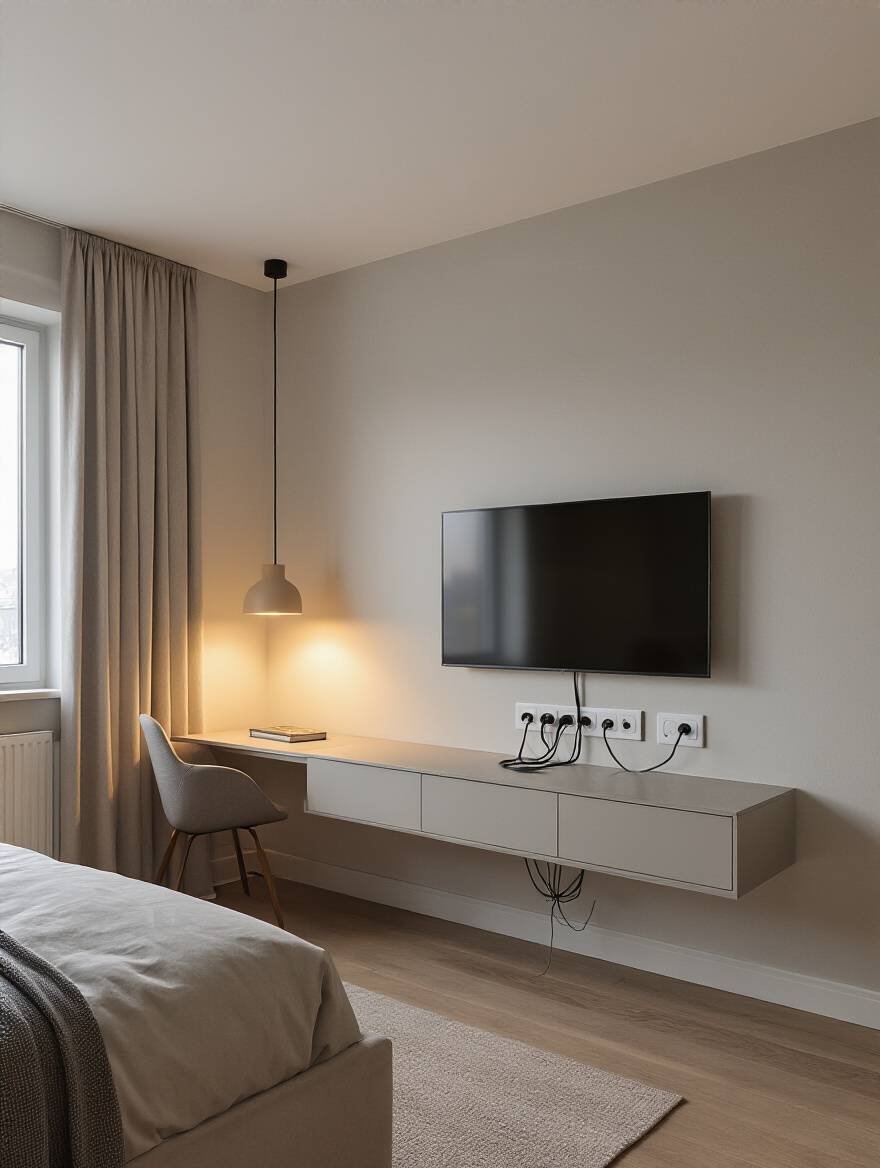
There are so many easy solutions. Use adhesive cable clips to run cords along the back of your furniture or along the baseboard. Get a decorative cable box to hide that bulky power strip and all its plugs. Bundle everything together with simple Velcro ties. A client of mine mounted his TV on the wall and we used a paintable cord cover that blended right into the wall. It made the entire room look cleaner, more high-end, and infinitely more peaceful.
Next, let’s make that technology work for you instead of against you.
Smart tech in the bedroom shouldn’t be about gimmicks. It should be about supporting your health and simplifying your routines. When used right, it can be a powerful tool for better sleep and more energy. My favorite application is smart lighting. You can program your lights to slowly dim in the evening, signaling to your body it’s time to wind down.
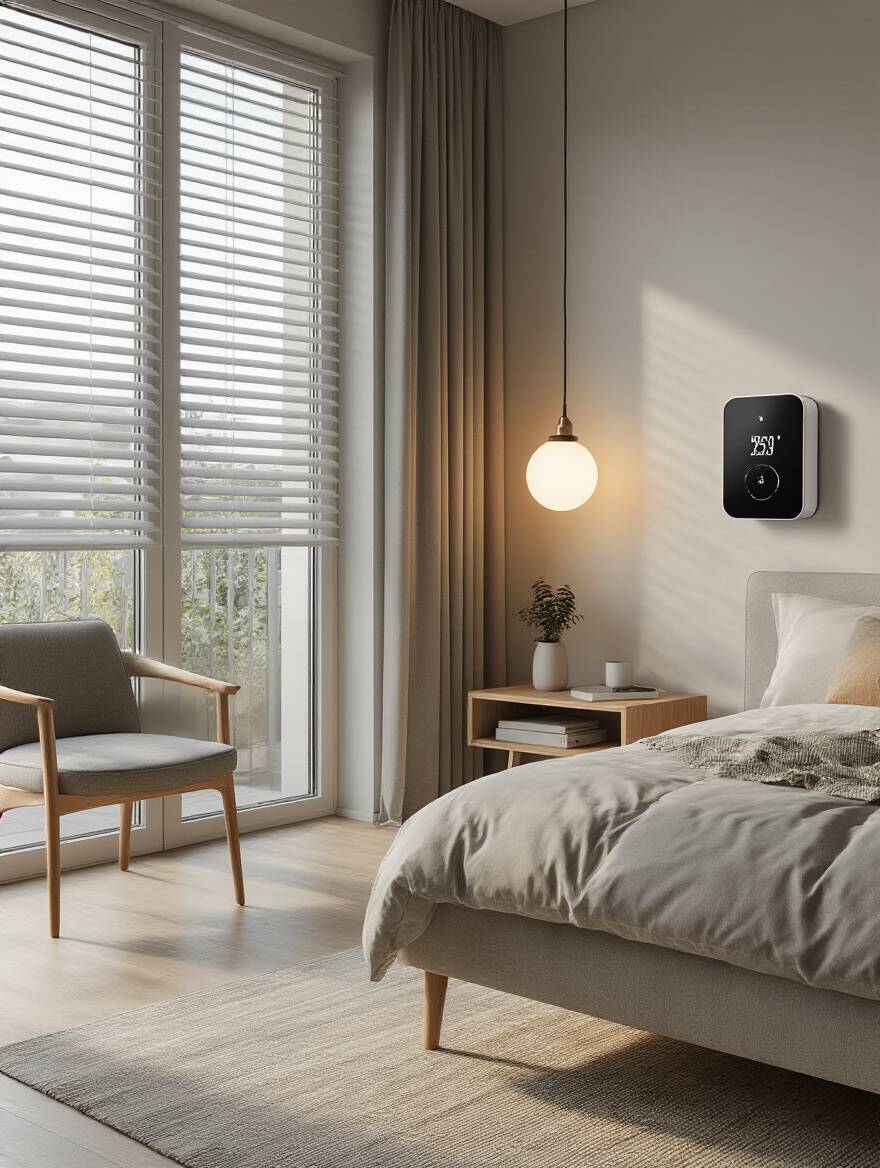
Then you can set up a “sunrise alarm” where the lights gradually brighten in the morning, waking you up naturally instead of with a jarring alarm. This is so much better for your circadian rhythm. A smart plug on your fan or a smart thermostat can ensure your room is at the perfect sleep temperature all night. The goal is to automate the environment so you can just focus on what’s important: resting and recovering.
The best tech in the world won’t matter, though, if you don’t maintain your space.
A beautiful room can descend into chaos fast if you don’t have a system. You can’t just do a massive clean-out once a year. The key is small, consistent effort. This isn’t about being a minimalist fanatic; it’s about respecting your space and your future self. The best, most sustainable method I’ve found is the “One-Touch” rule.
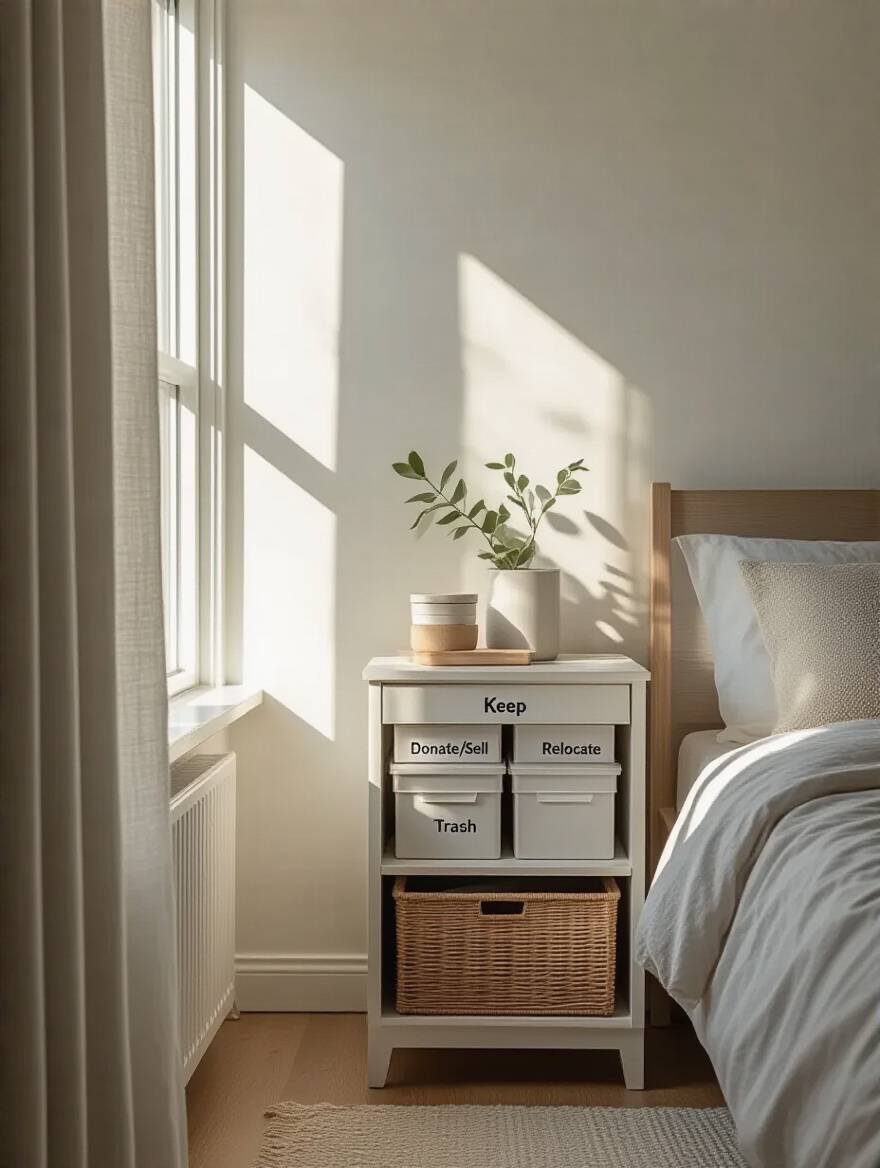
When you come into the room, deal with things immediately. Don’t put the mail on the dresser to sort later—deal with it now. Don’t throw your gym clothes on the chair—put them straight into the hamper. It takes two seconds. Pair this with a 5-minute “reset” every night before bed. Just put things back where they belong. This tiny habit prevents clutter from ever getting a foothold and keeps your sanctuary feeling calm and ready for you.
And because life changes, your room should be ready to change with you.
Your life isn’t static, so why should your bedroom layout be? Maybe today you need a corner for a desk, but in six months you’ll want that space for a yoga mat. Designing for flexibility means you can adapt your space without having to buy all new furniture. The key is to choose lightweight, mobile, or modular pieces.
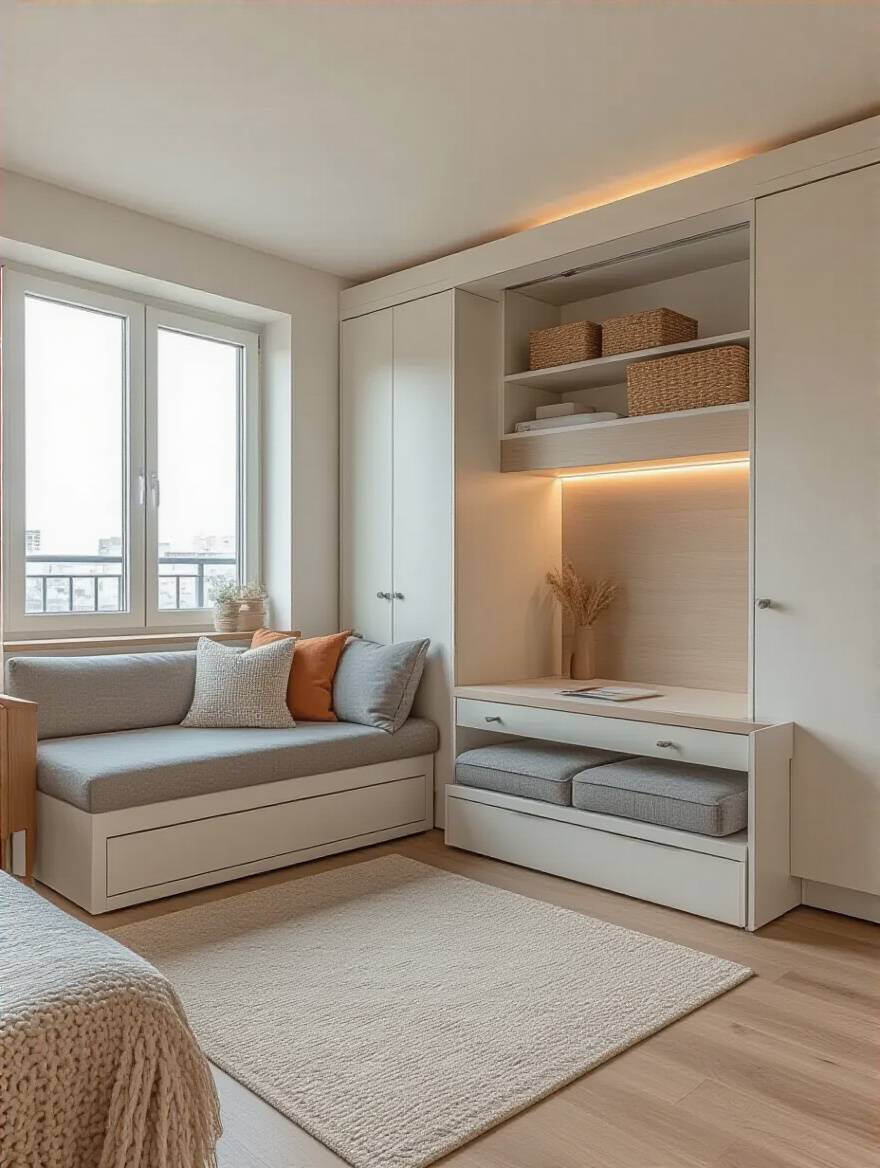
Think about a desk on wheels that can be moved easily. Or modular shelving that can be reconfigured. Even something as simple as choosing two smaller nightstands instead of one big, heavy dresser gives you more options for rearranging. This approach keeps your room feeling fresh and ensures it’s always serving your current needs, not the needs of the person you were two years ago.
Finally, the easiest way to keep your room feeling new and exciting.
You don’t need to do a full redesign to make your room feel brand new. The easiest, most cost-effective way to hit the reset button is by swapping out your textiles and small decor pieces with the seasons. It’s an instant mood-booster and keeps your space from feeling stagnant.
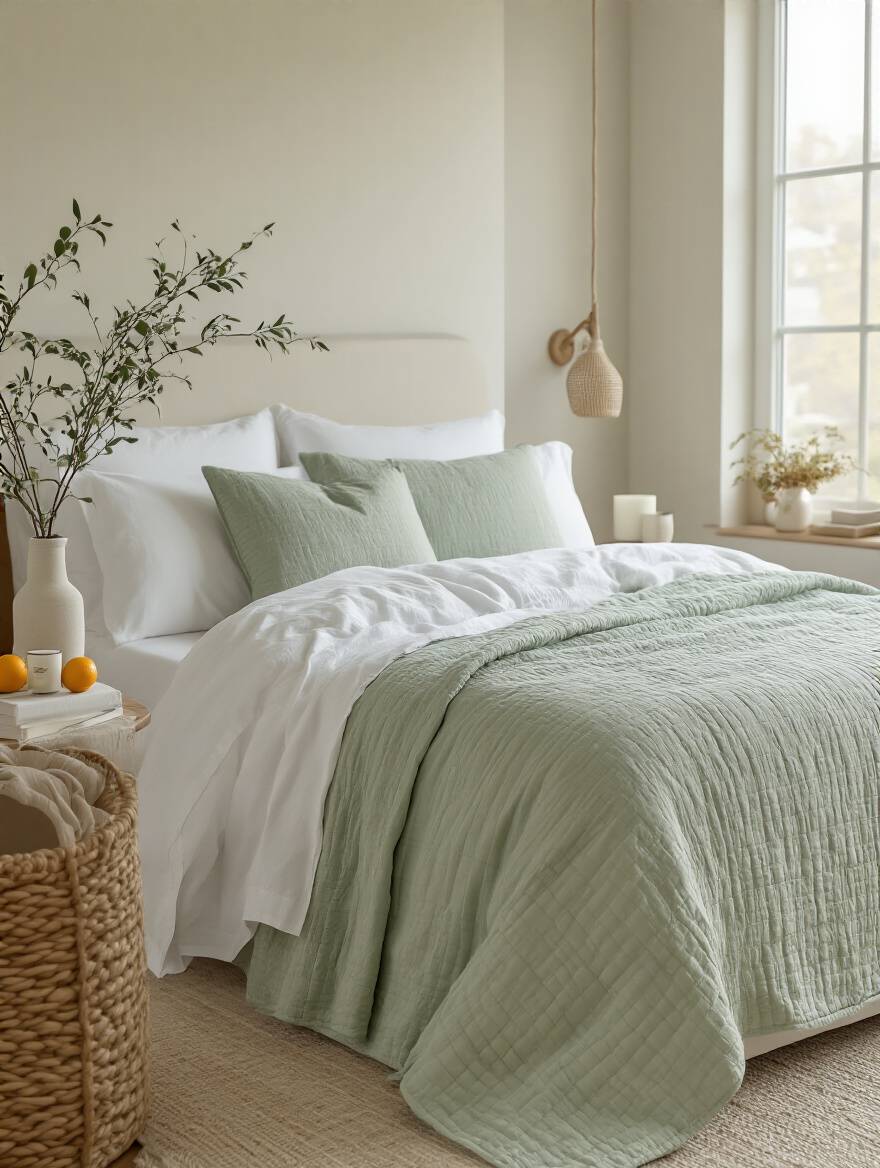
Have a set of lightweight, breathable linen or cotton bedding in a brighter color for spring and summer. Then, for fall and winter, swap it out for cozy flannel or a rich velvet duvet in a deeper, warmer hue. Change out your throw pillows and blankets at the same time. You can even switch the scent of your candle from something floral to something spicy. It’s a small change that makes a huge psychological impact, keeping your personal sanctuary aligned with the energy of the world outside.
Look, designing your apartment bedroom isn’t about creating a perfect, untouchable showpiece. It’s about building a functional, personal performance tool. It’s your charging dock. It’s your recovery zone. Every single choice—from the color on the walls to the organization in your closet—either adds to your energy or drains it. By being intentional and using these strategies, you’re not just decorating; you’re investing in better sleep, less stress, and more energy for everything else you want to achieve.
Take these ideas and make them your own. Start with the one that feels like the easiest win or solves your biggest headache. The goal is progress, not perfection. Create a space that supports your goals, reflects your personality, and gives you a genuine sense of peace the moment you walk through the door. That’s a space that will help you win the day, every day.